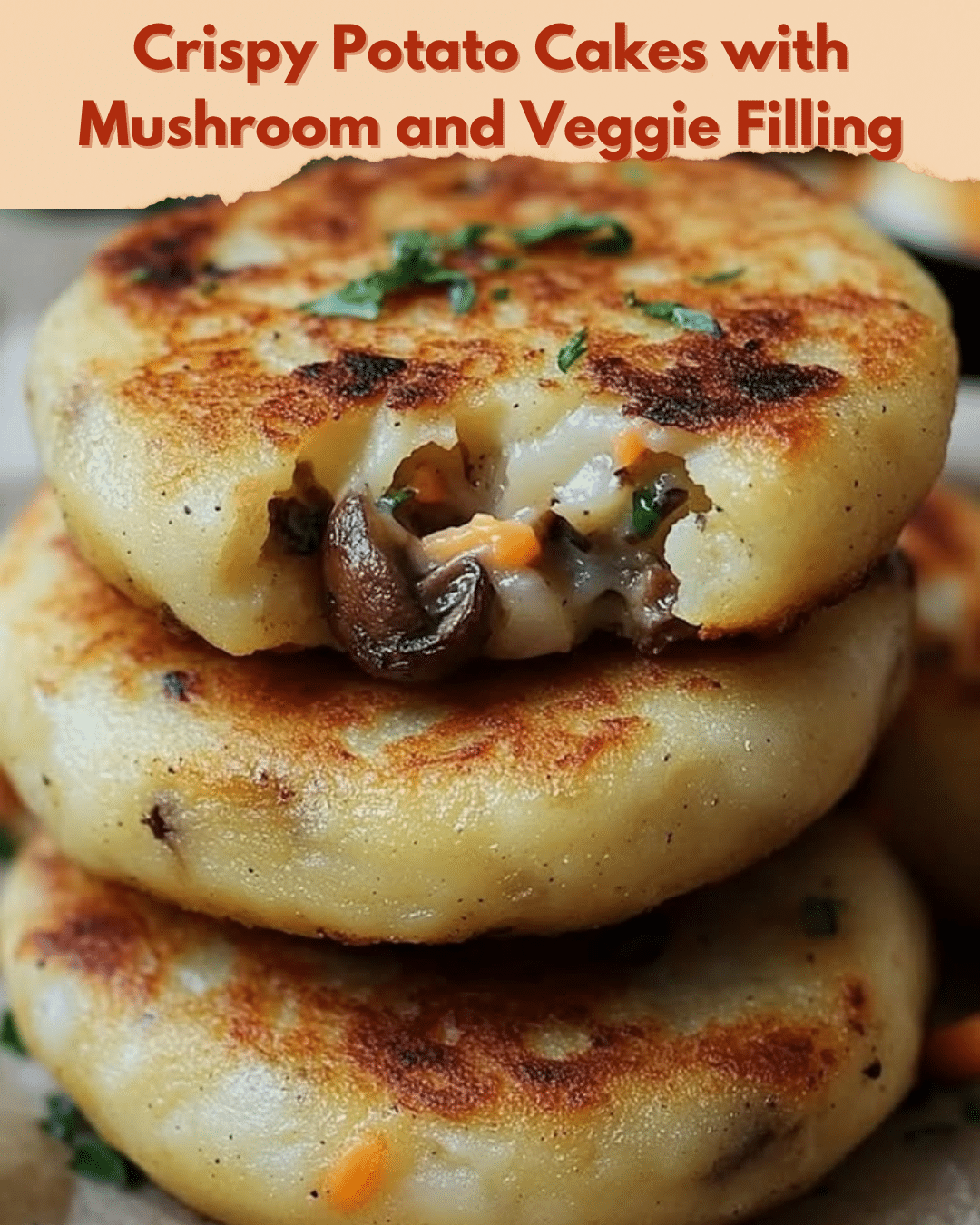Crispy Potato Cakes with Mushroom and Veggie Filling: A Delightful Vegan Recipe
Imagine biting into a crispy, golden potato cake that perfectly melts in your mouth, with a savory mushroom and veggie filling bursting with flavors inside. Our Crispy Potato Cakes with Mushroom and Veggie Filling are much more than a side dish—they’re a culinary experience. Packed with earthy mushrooms and vibrant veggies, these potato cakes are not only pleasing to the palate but also a hearty addition to any meal. Whether you’re a plant-based eater or simply looking for a delicious new dinner idea, these potato pancakes are sure to satisfy your cravings and leave you wanting more.
The harmony of textures and flavors in these potato cakes is unparalleled. The crispy exterior gives way to a tender interior filled with umami-rich mushrooms, creating a delightful contrast that keeps each bite exciting. As these potato cakes sizzle in the pan, your kitchen will be filled with an irresistible aroma that calls everyone to the table. Not only do they look impressive with their crispy edges and vibrant filling peeking through, but they also deliver in taste, making them a delight for your taste buds and your eyes.
With the right combination of ingredients, these potato cakes become a versatile dish that can be a stand-alone treat or an exciting accompaniment to a larger meal. Crafted with simple kitchen staples, these cakes are an accessible and budget-friendly option for anyone aiming to enjoy a quality meal without spending hours in the kitchen. Let the discovery of this recipe open the door to a world of plant-based delight that doesn’t compromise on taste or texture.
Quick Recipe Highlights
- Flavor Profile: The earthy notes of sautéed mushrooms combined with fresh veggies lend a robust flavor, unveiled in every bite of these crispy potato cakes.
- Texture: Each cake features a crispy exterior with a soft, savory interior, offering a satisfying crunch followed by a melt-in-your-mouth finish.
- Aroma: The delicious aroma of garlic, herbs, and fried potatoes fills the air, ensuring an appetizing experience even before the first bite.
- Visual Appeal: Beautifully browned and speckled with vibrant colors from the veggie filling, these cakes are a feast for the eyes and the plate.
- Skill Level Needed: While these cakes require some finesse in shaping and frying, they’re accessible for intermediate cooks looking to refine their skills.
- Special Equipment: A non-stick skillet or frying pan is essential to achieve the perfect crispy exterior, ensuring the cakes do not stick or break apart.
Recipe Overview
- Difficulty Level: This recipe is suited for those comfortable with multitasking and mindful kitchen skills. Though it requires attention during the frying process, it’s a fulfilling challenge for home cooks.
- Category: Perfect as an appetizer, snack, or side dish, offering versatility in serving and pairing with various main courses or alongside a refreshing salad.
- Cuisine: Rooted in European culinary traditions, these potato cakes offer a taste of rustic comfort food with a contemporary plant-based twist.
- Cost: Reasonably priced, these cakes cost little more than the sum of potatoes, mushrooms, and everyday veggies, making it an economical choice for any budget.
- Season: Though enjoyable year-round, they shine in fall and winter when root vegetables and hearty meals are most welcome.
- Occasion: Suitable for casual dinners, family gatherings, or even holiday feasts, offering something special for any occasion.
Why You’ll Love This Recipe
The allure of these crispy potato cakes lies in their perfect balance of taste and texture. Each bite combines the crispy, golden brown potato crust with the umami-rich, tender filling of mushrooms and veggies. The contrast offers a delightful experience that tantalizes your taste buds and keeps you reaching for more.
Convenience is one of the strongest benefits of this recipe. Requiring just a few key ingredients, it can be whipped up in less than an hour, making it an ideal choice for weeknight dinners or impromptu gatherings. Plus, the ingredients are kitchen staples—meaning this dish is as accessible as it is delicious.
Aside from being delicious, these crispy potato cakes offer numerous nutritional benefits thanks to the use of whole foods. Packed with vitamins and minerals from the mushrooms and vegetables, along with the energy-boosting carbs from potatoes, these cakes are as nourishing as they are mouthwatering.
Whether you’re hosting guests or enjoying a simple night in, these potato cakes are sure to impress. Their harmonious flavors and textures make them a crowd-pleaser that appeals to all palates, while their elegant appearance ensures they’re always a welcome addition to the table.
Finally, making these potato cakes is surprisingly economical. With simple, affordable ingredients and minimal preparation, you can provide a filling and satisfying meal that doesn’t break the bank. It’s a testament to the fact that great taste doesn’t have to come with a hefty price tag.
Historical Background and Cultural Significance
Originating in Europe, potato cakes or pancakes are a testament to the ingenuity of turning simple ingredients into something extraordinary. In many European cultures, variations of these cakes have been enjoyed for centuries, particularly in regions where potatoes are a staple.
Potato cakes hold a significant place in cultural food traditions, often associated with family gatherings and festive occasions. They symbolize warmth and comfort, being served in households across the continent during chilly months to provide sustenance and cheer.
Over time, the potato cake recipe has evolved to incorporate a variety of fillings, reflecting the seasonality of ingredients and regional preferences. From cheese and meats in some regions to mushrooms and veggies in others, the adaptability is part of what makes them beloved.
Today, potato cakes with vegetarian fillings are celebrated for their ethical and environmental benefits, appealing to a modern audience that values sustainability as well as flavor. Encouraging creativity and adaptation, this dish is a bridge between tradition and contemporary culinary practice.
Ingredient Deep Dive
Potatoes are the cornerstone of this recipe, with their history as a reliable food source during times of need. Their starchy nature ensures a crispy exterior and a soft, inviting texture inside. When selecting potatoes, look for firm ones without blemishes. They store best in a cool, dark place and can be substituted with sweet potatoes for a twist.
Mushrooms add a rich, umami element to the filling, making the dish more satisfying without the need for meat. They are low in calories but packed with B-vitamins and minerals, elevating the nutritional profile. Choose firm mushrooms, store them in a paper bag in the fridge, and consider portobello or shiitake for a deeper flavor.
Vegetables such as carrots and onions accentuate the flavor and texture of the filling. They bring brightness and sweetness to the savory mix. Fresh, brightly colored vegetables should be your go-to choice. Stored properly, they remain fresh and can be replaced with other seasonal favorites as needed.
Common Mistakes to Avoid
- Overcrowding the pan can result in uneven cooking and sticking. It’s important to give each potato cake enough space.
- Undercooking the potatoes can lead to a hard texture; ensure they’re fully tender before mashing.
- Not properly seasoning the filling may result in bland cakes. Taste and adjust spices before assembling the cakes.
- Skipping the press step can prevent a crispy exterior from forming, so press the cakes gently with a spatula.
- Using wet potatoes creates steam, inhibiting browning. Pat them dry to ensure that coveted crispy crust.
- Overfilling the cakes risks them breaking apart. If they seem fragile, reduce the amount in each patty.
- High heat is crucial for browning but can cause burns if set too high. Aim for a moderate temperature for a uniform cook.
- Forgetting to cool the filling can cause structure loss as the cakes heat, leading to collapse.
- Using the wrong oil affects flavor and smoking point. Opt for neutral oils like canola or avocado for best results.
- Ineffective flipping might break the cakes. Utilize two spatulas: one for support and another to turn them gently.
Essential Techniques
Mastering the crisp frying technique ensures the distinctive outer shell, a key to the overall eating experience. Using the right oil balance and heat level is paramount; too much oil can soggy the cakes, while too little can cause sticking. It’s crucial to employ sensory cues—listening for consistent sizzling, observing color changes, and feeling the preliminary rigidity before flipping.
The mushroom sauté is foundational to the flavor profile. Gentle, slow cooking releases their deep umami while preventing moisture retention that can lead to soggy filling. Keep stirring to aide even cooking, ensuring they hit their aromatic peak without losing firmness.
Forming the cakes is as much an art as a science. Shape with consistent pressure to maintain structure, utilizing cling film for assistance if necessary. Overly compacting can result in dense cakes without internal contrast, so aim for medium firmness—enough to hold together yet tender to yield under a fork.
Precise seasoning cannot be overstated. Mix and taste frequently to identify balance, considering all elements—earthy mushrooms, sweet carrots, and savory potatoes. Remember that salt amplifies crispness and counterbalances natural sweetness.
Utilizing visual cues ensures timing accuracy without reliance on timers. The rich golden-brown crust indicates readiness beyond numeric cook times alone. Pair with auditory signs—a robust sizzle without spitting oil—to inform optimal moments for adjustments or removal from heat.
Pro Tips for Perfect Crispy Potato Cakes
For the perfect crispy exterior, heat oil adequately before adding the cakes and avoid overcrowding to maintain consistent heat levels.
Don’t rush the mashing process; smooth potatoes ensure cohesive cakes. A ricer or masher helps achieve the finest consistency without lumps for even cooking.
Use fresh herbs judiciously to heighten freshness. Parsley or thyme additions infuse complementary flavors that elevate the subtlety of mushrooms and veggies.
Chill the filling before assembly to make it more manageable and prevent premature clean, which may negatively impact the cohesion during cooking.
Experiment with textures; a mix of shredded and diced vegetables provides variability that enhances interest both visually and on the palate.
Achieving the right mix of textures in the filling ensures a multilayered experience. Finely diced veggies blend seamlessly, while shredded counterparts give a subtle layer of contrast.
Consider preparing the base mash and filling separately ahead of time. Allow time to cool and combine just beforehand for maximum flavor infusion and textural integrity.
When selecting oil, consider flavor pairing. While neutral oils work, experimenting with flavored oils like garlic or truffle can introduce subtle nuances to the final dish.
Variations and Adaptations
Regional variations introduce specific elements native to the area, whether through traditional cheese fill-ins in alpine regions or blends of spices in Eastern Europe. Each adaptation acknowledges local produce and tastes, often determined by geographic availability.
Seasonal adaptations ensure year-round enjoyment. Summer variations might incorporate zucchini, alongside seasonal herbs, providing a lighter profile, while winter options might lean into denser squash or kale infusions for hearty warmth.
Dietary modifications can shift ingredients towards any specific nutritional needs. Gluten-free versions can omit breadcrumbs with almond flour substitutes, and vegan cheese alternatives maintain this recipe’s plant-based integrity if desired.
Flavor variations intensify by shifting across spices. Incorporating cumin and coriander enhances warmth, while chili infusions add subtle heat. Each twist subtly highlights different elements of basic ingredients.
Texture can similarly adapt by altering the size and method of preparation for the potato base—switching from mashed formations to spiralized variants that maintain length for deeper crunch.
Presentation alternatives cater to specific dining contexts. Stack small, bite-sized cakes for hors d’oeuvres, or form larger options for standalone plates. Consider bright herb garnishes and balsamic drizzles for sophisticated serving.
Serving and Presentation Guide
Plating techniques can elevate your potato cakes from everyday to extraordinary. Consider stacking them with garnishments for height, or align in intricate patterns for visual intrigue. Use shallow, larger plates to highlight individual detail.
Garnishing with bright herbs or sharp sauces enhances not only visual appeal but additional layers of flavor contrast. A scattering of seasonal microgreens or petals adds sophistication.
Traditional accompaniments, like cooling sour cream or apple sauce, can temper savory notes, adding balanced relief. Alternatively, consider zesty relishes or crisp pickled vegetables to balance richness.
Modern serving suggestions include creative dips or infused oils, instead of heavier creams, to preserve lightness. Choose vibrant accompaniments complementing the internal veggie filling.
Temperature considerations dictate full enjoyment. Serve warm from the pan for optimal experience; arrange warming trays if necessary for large gatherings to maintain crispy satisfaction.
Portion control can dictate your cake size. For larger meals, consider smaller servings; for informal gatherings, larger cakes offer substantial satisfaction, easily shared among friends.
Wine and Beverage Pairing
Light white wines such as chardonnay or sauvignon blanc complement the earthy flavors within, maintaining freshness without overpowering delicateness. Serve them chilled to enhance crisp textures.
Non-alcoholic alternatives include bright, citrus-infused sparkling waters that provide palate-cleansing acidity, or iced herbal teas emphasizing vegetal notes.
Coffee and tea pairings bring earthiness to the forefront; rich-roasted blends intensify mushroom undertones, while lighter green teas uplift subtle nuances.
Temperature considerations can amplify contrasts between course elements—icy drinks accentuate fresh warmth, keeping flavors defined.
Serving suggestions can span beyond standard glassware. Consider sleek tumblers for modern appeal or classic wine glasses for elegance.
Storage and Shelf Life
Encapsulation in airtight containers allows storage of cooked cakes within the refrigerator, extending their enjoyment for up to 3 days without significant texture loss.
Temperature requirements dictate quick cooling followed by consistent refrigeration. Fluctuations can compromise structural integrity and flavor retention, so ensure vigilance.
Container recommendations favor shallow glass or BPA-free plastics, with absorbent liners within to prevent moisture accumulation affecting crispiness.
Signs of spoilage include obvious discoloration or pronounced off-scents, indicating the need for disposal and safe eating practices.
Reheating instructions involve moderate oven settings or skillet revisits, avoiding microwaves that risk sogginess. Retain crispiness by moderate exposure to dry heat.
Freezing guidelines involve pre-freezing on trays to shield from compression, followed by layering between parchment. Consume within 3 months for best quality.
Make Ahead Strategies
Advance prep can be divided into steps, ensuring quality amid flexible schedules. Base mash and filling can be constructed separately ahead, combining day-of assembly.
Storage between steps necessitates cooling, keeping components fresh until needed together. Airtight containers support this process, preventing moisture loss or contamination.
Quality impact assessment guarantees outcome integrity is maintained, reinforcing confident planning without flavor degradation over time.
Assembly tips encourage thoroughness without haste. Form cakes with deliberate guidance, minimizing abandonment to avert breakage during cooking.
Reheating guidelines to freshen prepare-ahead elements propose re-crispening through oven warmth, maintaining the original outer crust appeal.
Addition of fresh elements boosts sensory appeal, ensuring brightness pairs against extensive cook times suggests including herbs or zest enhancements.
Scaling Instructions
Halving the recipe requires precise calculations to preserve ingredient integrity across smaller volumes. Measure meticulously to maintain consistency.
Doubling or tripling invites equipment considerations; pan size might limit ability, requiring multitasking or additional pieces to accommodate increased quantities.
Timing modifications accommodate increased volumes. Extended cooking may be necessary, altering traditional markers by smell and sight rather than strict adherence.
Storage considerations ensure earlier completion stays fresh; assign ample refrigeration space for expanded yield, planning containers to match scope and size.
Maintaining quality over larger batches demands careful supervision, affirming taste balance and visual outcomes hold true irrespective of magnitude.
Nutritional Deep Dive
Macro breakdown highlights carbohydrates from potatoes balanced by vegetable-originated fiber, promoting sustained energy without over-reliance on singular nutrients.
Micronutrient analysis accounts for mushrooms and vegetables’ mineral abundance, offering appreciable quantities of trace elements necessary for comprehensive health.
Health benefits stem from primarily plant-based ingredients with low saturated fats and cholesterol presence. Balanced consumption aids satiety while reducing cardiovascular risk factors.
Dietary considerations ensure nutritional diversity, accommodating vegetarian and ethical perspectives without sacrifice of flavor depth or satisfaction.
Portion analysis defines servings, reinforcing nutrition data accessibility. Modifying these considerations to suit individual needs enables personalized dietary adherence.
Weight management tips encourage portion awareness without restriction, embracing whole food’s fulfilling potential over processed alternatives.
Dietary Adaptations
Gluten-free adaptations involve substitute flours like almond or rice, maintaining cohesion without traditional wheat’s gluten presence.
Dairy-free options acknowledge dietary restrictions, utilizing plant-based creams or alternative oils for frying and richness infusion without lactose.
Vegan approaches adhere to original intents, facilitating enjoyment without animal-based inclusions. Choosing plant-derived ingredients promotes harmony with lifestyle and practice.
Low-carb considerations allow potato adjustment or alternative root vegetable utilization, preserving structure with substituted grains or binders.
Keto incorporates protein-rich components, where permitted. Commissioner avocados and nuts within regulations offer texture-hosted enhancements to support adherence.
Paleo reflects ancestral eating habits, emphasizing minimally-processed foundations. Ingredient integrity underpins adaptation, grounding iterations in natural fundamentals.
Low-FODMAP restricts specific components, preserving flavor without discomfort. The recognition of alternative seasoning balances sharpens awareness, directly ensuring pleasurable post-consumption comfort.
Other specific diets—be they medically indicated or personally chosen—illustrate this recipe’s capacity for modification, reinforcing versatility amidst competent application.
Troubleshooting Guide
Texture issues often arise from inadequate drying; persistent potato moisture undermines structure. Ensure dryness at all stages for correct outcome.
Flavor balance can falter without comprehensive seasoning. Incremental spice additions reinforce layers without overpowering subtleties.
Temperature problems, whether arising from over- or under-heating, dictate attention to consistency. Maintain moderate heat for steady cooking without rush.
Equipment challenges stem from inappropriate tools, favoring nonstick pans for most seamless results. Consider adjust equipment fit to recipe scale.
Ingredient substitutions provide opportunities for variation. Consistency must be struck between novelty and characteristic expectations for success.
Timing concerns can necessitate adjustment relative to season or equipment. Flexible approaches to signals or preparedness compensate for rigid structures.
Recipe Success Stories
Community feedback frequently celebrates their versatile nature and unwavering satisfaction, succinctly encapsulating taste and appearance within each bite.
Variation successes encapsulate creative twists on a classic format, inviting regional or seasonal influences while preserving core elements.
Adaptation stories illustrate harmony between global palates, demonstrating its adaptability against cultural requirements or preferences for inclusivity.
Reader suggestions underscore cooperation in refinement; ideas illustrate creativity meeting practicality within parameterized experiences.
Photography tips accompany visual captures, seizing momentary frames of interest that amplify culinary engagement. Light, form and detail come alive as deliciousness is immortalized.
Frequently Asked Questions
A1: Yes, baking is a healthier alternative that still yields delicious results. Place cakes on a parchment-lined sheet, brush with oil, and bake until golden brown, turning once for even crispiness.
Q2: What types of mushrooms work best?
A2: Cremini or button mushrooms suit most tastes, but shiitake or portobello add a deeper umami flavor. Experiment with combinations to discover your preferred variety!
Q3: Can these be made gluten-free?
A3: Absolutely! Substitute regular flour for gluten-free alternatives, ensuring consistency remains suitable for binding without sacrificing flavor.
Q4: How should I store leftovers?
A4: Store in an airtight container for 3 days in the refrigerator. To re-crisp, heat them in a skillet or 400°F oven briefly before serving to restore texture.
Q5: Can I add cheese to the filling?
A5: Cheese enhances flavor and richness. Choose harder cheeses for their low moisture and ability to melt seamlessly with filling components.
Q6: What’s the best oil for frying?
A6: Opt for neutral oils like canola or grapeseed due to their high smoke point and lack of flavor, maintaining focus on the filling intricacies.
Q7: Are substitutions available for the vegetable filling?
A7: Seasonal veggies can freely swap in, just ensure uniform size and moisture adjustments to underpin structural success.
Q8: Do these freeze well?
A8: They freeze excellently—pre-freeze cakes individually before storing, preventing compression. Simply bake from frozen state, extending this dish’s versatility.
Q9: Is sautéing mushrooms unnecessary?
A9: It’s critical for extracting moisture and concentrating flavors, safeguarding against soggy or bland cake middle zones.
Q10: Can sweet potatoes replace conventional ones?
A10: Yes, their natural sweetness diversifies profile complexity and introduces nutrition diversity. Adjust moisture considerations according to fibrous nature.
Additional Resources
Related recipes can expound upon favorite ingredients, encouraging exploration into unique formulations or supplementary meal complements.
Technique guides illuminate each critical step of preparation and presentation. Advancing knowledge solidifies confidence, ensuring shared culinary success.
Ingredient information advances your pantry skills with insight into selections valuing freshness and locality, maintaining essential qualities across varying geographies.
Equipment recommendations provide informed choices, promoting investments that reflect culinary aspirations and reliability regardless of scope or project scale.
Seasonal variations immerse you in contemporary practices, illustrating how food transcends mere sustenance, embodying expressions within shared rituals and celebrations.
Print
Crispy Potato Cakes with Mushroom and Veggie Filling
Description
Deliciously crispy potato cakes filled with a savory mushroom and vegetable mixture, perfect as a main course or appetizer.
Ingredients
For the Crust:
- 4 large potatoes, peeled and grated
- 1 cup mushrooms, finely chopped
- 1/2 cup bell peppers, finely diced
- 1/2 cup onions, finely diced
- 2 cloves garlic, minced
- 1/2 cup all-purpose flour
- 2 eggs, beaten
- Salt and pepper to taste
- 2 tablespoons olive oil
Instructions
1. Prepare the Crust:
- Squeeze excess moisture from the grated potatoes using a clean kitchen towel.
- In a large bowl, mix grated potatoes, mushrooms, bell peppers, onions, garlic, flour, and eggs. Season with salt and pepper.
- Heat olive oil in a non-stick skillet over medium heat. Scoop portions of the potato mixture into the skillet, flattening each to form cakes.
- Cook each cake for 4-5 minutes on each side until golden brown and crispy.
- Drain on paper towels and serve hot.
Notes
You can customize the seasonings to taste.





